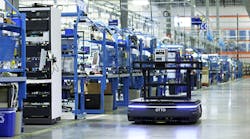GE Healthcare has reduced the size of its repair cell stations at its repair operations center by 40%, due to a self-driving vehicle named OTTO.
A fleet of OTTOs is used to deliver parts to workstation cells to handle over 2,000 repairs of medical devices weekly at GE’s Healthcare’s 280,000 square foot Repair Operations Center in Milwaukee, Wisc.
OTTO, which was designed for material transport in industrial environments, does not require fixed infrastructure (no beacons, magnetic tape or pre-defined laser paths). Its provides obstacle detection and avoidance, and dynamically moves through facilities in the most efficient manner to reach the destination point. Each vehicle can operate 24/7 by using opportunity charging technology to autonomously visit its charger for frequent, rapid charges between missions
GE says that the vehicles from OTTO Motors (a division of Clearpath Robotics Inc.) contribute to its lean manufacturing strategy as the facility can provide faster repairs.
“We needed to find an on-demand solution for moving materials throughout the facility,” explained Patricio Espinosa, director, Americas Repair Operations at GE Healthcare. “OTTO is a perfect solution because it gets materials where they need to be, when they need to be there. The system can make a decision to turn and take different routes, which was essential for us. Our process changes every day depending on what parts come in for repair, but OTTO can accommodate all of them.”
Parts are delivered on-demand and navigate from the pick-up point directly to the destination, always taking the fastest route. OTTO is also able to take on multiple jobs within the plant; the same vehicle can be used in different applications across the facility, from supplying parts to repair cells and moving finished goods to shipping zones. This multi-functional capability has led to a 66% increase in productive floor space.
“Space is in shortage in our work areas, so it’s helpful that we can call OTTO on demand and have it come pick up our parts,” says Joe Germait, manufacturing technician at GE Healthcare. “The pick-up times are really quick, and it allows us to switch to the next part more quickly. Occasionally we meet up with OTTO in the aisle ways and it goes right around us.”
Previous GE repair centers required technicians to manually push carts to move equipment into repair cells and shipping areas. Material transport was typically dependent on other manual tasks, which often led to delays. Furthermore, facilities suffered from wasted floor space due to room needed for carts and fixed infrastructure.



